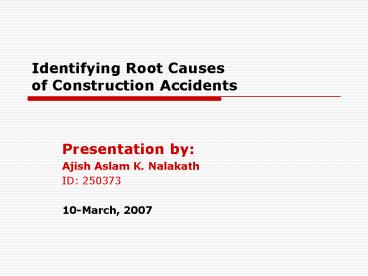Identifying Root Causes of Construction Accidents - PowerPoint PPT Presentation
1 / 19
Title:
Identifying Root Causes of Construction Accidents
Description:
Construction accounted for only 5% of US workforce, but claimed 20% of all ... Human error is any one set of human actions that exceed some limit of acceptability' ... – PowerPoint PPT presentation
Number of Views:1725
Avg rating:3.0/5.0
Title: Identifying Root Causes of Construction Accidents
1
Identifying Root Causes of Construction Accidents
- Presentation by
- Ajish Aslam K. Nalakath
- ID 250373
- 10-March, 2007
2
Organization of Presentation
- Introduction
- Objectives
- Accident Causation Models
- Domino Theory
- Multiple Causation Model
- Human Error Theories
- Behaviour Models
- Human Factor Models
- Ferrel Theory
- ARCTM Construction Model
- Unsafe Conditions
- Accident Investigations using ARCTM
- Conclusions
3
Introduction
- Construction accounted for only 5 of US
workforce, but claimed 20 of all occupational
fatalities and 9 of all disabling occupational
injuries (Accident 1997) - This uniqueness of the Construction Industry
dictates the need to tailor many of the
contemporary accident causation models and human
error theories - The answers that accident investigations provide
for what and how questions, should be used to
determine why the accident occurred - By knowing the actual causes, prevention efforts
could be directed at these root causes of
accidents and not at symptoms, leading to more
effective accident prevention
4
Objective of Research
- To introduce an Accident Root Causes Tracing
Model (ARCTM) tailored to the needs of the
Construction Industry - To provide management with a simple and easy to
use template for systematically and rapidly
determining why an accident occurred, so that
more effective measures for prevention could be
implemented
5
Accident Causation Models
- Accident prevention is an integrated program, a
series of coordinated activities, directed to the
control of unsafe personal performance and unsafe
mechanical conditions, and based on certain
knowledge, attitudes, and abilities (Heinrich,
1980)
6
Accident Causation Models..
- DOMINOS THEORY
- Heinrich developed this theory of accident
causation in which an accident is presented as
one of five factors in a sequence that results in
an injury - Ancestry Social environment
- Fault of person
- Unsafe act and/or mechanical or physical hazard
- Accidents
- Injury
7
Accident Causation Models..
- DOMINOS THEORY
- People are the fundamental reason behind
accidents - Management having the ability is responsible
for the prevention of accidents (Petersen, 1982) - Over the years, the domino theory has been
updated with emphasis on management as a primary
cause of accidents, and the resulting models were
named as Management Models or Updated Domino
Models
8
Accident Causation Models..
- MULTIPLE CAUSATION MODEL
- Peterson introduced this management non-domino
based model - Many contributing factors, causes, and subcauses
are the main culprits in an accident scenario and
hence named multiple causation - Trying to find the unsafe act or condition is
dealing only at the symptomatic level, because
the act or condition may not be the root cause - Root causes must be found to have permanent
improvement
9
Human Error Theories
- BEHAVIOUR MODELS
- Human error is any one set of human actions that
exceed some limit of acceptability - Human error is the main cause of accidents
- There are permanent characteristics in a person
that make him/her more likely to have an accident
(Accident Proneness Theory) - Goals Freedom Alertness Theory (Kerr, 1957) and
Motivation Reward Satisfaction Theory (Petersen,
1975) further explain the reason for accident
repeaters - Understanding the limitations of humans physical
and psychological capabilities, better designed
tasks, tools and work places have to be provided
(Human Factors Engineering)
10
Human Error Theories
- HUMAN FACTOR MODELS
- Extreme environment characteristics and overload
of human capabilities (both physical and
psychological) are factors that contribute to
accidents and human error - Understanding the limitations of humans physical
and psychological capabilities, better designed
tasks, tools and work places have to be designed
(Human Factors Engineering)
11
Human Error Theories
- FERREL THEORY
- Human errors are due to three situations
- Overload
- Incorrect response / Basic Incompatibility
- Improper activity
12
ARCTM Construction Model
- An occupational accident will occur due to one or
more of the following root causes - Failing to identify an unsafe condition that
existed before an activity was started or that
developed after an activity was started - Deciding to proceed with a work activity after
the worker identifies an existing unsafe
condition - Deciding to act unsafe regardless of initial
conditions of the work environment
13
ARCTM Construction Model
- UNSAFE CONDITIONS
- Unsafe conditions are due to one of the following
conditions - Management actions / inactions
- Worker / Coworker unsafe acts
- Nonhuman related event (s)
- Unsafe condition is a natural part of the initial
construction site conditions
14
ARCTM Construction Model
- ACCIDENT INVESTIGATIONS USING ARCTM
- STEP1
- Determine whether there was one or more unsafe
conditions that faced the worker involved in the
accident (before or after starting the activity)
15
ARCTM Construction Model
- ACCIDENT INVESTIGATIONS USING ARCTM
- STEP2
- If a worker was faced by an unsafe condition,
determine whether the worker had identified the
unsafe condition
16
ARCTM Construction Model
- ACCIDENT INVESTIGATIONS USING ARCTM
- STEP3
- If there were no unsafe condition(s) that faced
the worker involved in the accident, determine
whether the worker acted unsafe or not
17
(No Transcript)
18
Conclusions
- ARCTM complements construction investigation
techniques by raising many important questions
and possible answers that help identify the root
causes behind occupational accidents - ARCTM emphasizes the need to consider worker
training, worker attitude, and management
procedures when prevention efforts are
contemplated - ARCTM provides a template for systematically and
rapidly determining areas requiring more
investigations, so that labor and management may
provide more effective measures for preventing
accidents
19
- Thank You































